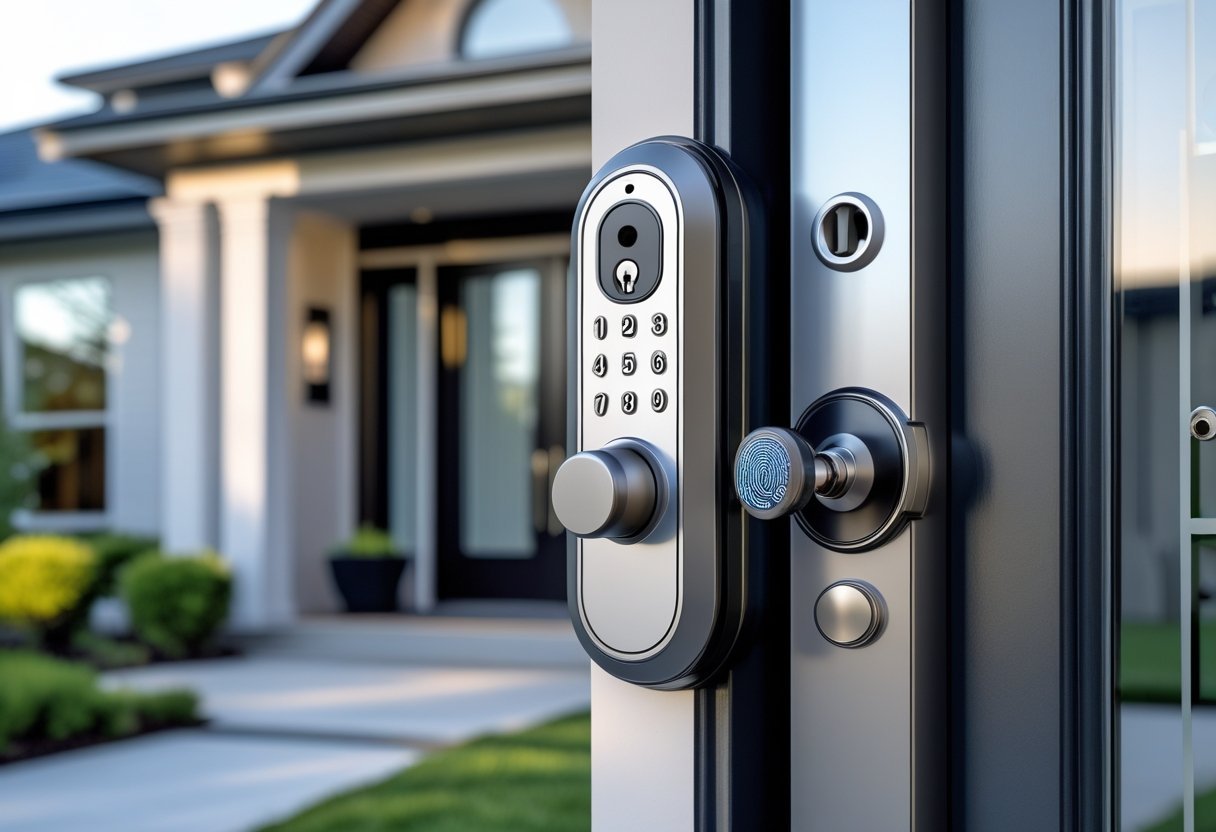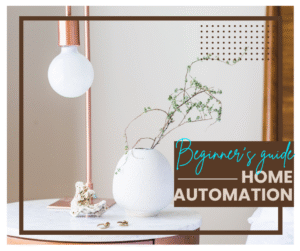As an Amazon Associate, we may earn a commission if you make a purchase — at no extra cost to you.
Top 5 Smart Locks for a Keyless Home (2025 Review): Updated Guide for Secure, Convenient Entry
Upgrade your home with the best smart locks in 2025. Explore keyless entry, Alexa & Apple HomeKit options. Secure & convenient living starts here.
Finding the best smart locks for home in 2025 is easier than ever, with advanced keyless entry options designed for security and convenience. Whether you want a Wi-Fi smart lock, a keypad lock, or Apple HomeKit integration, today’s top models make it simple to protect your home without carrying keys. In this updated guide, we compare the top 5 smart locks for home that deliver reliable performance, easy installation, and compatibility with smart assistants like Alexa and Google Home.
🔒 Why This Smart Lock Guide Matters
Choosing the best smart lock for your home in 2025 isn’t just about convenience — it’s about safety, peace of mind, and compatibility with your modern smart home setup. This post cuts through the noise, so you don’t waste money on locks that don’t fit your lifestyle.
📘 What You’ll Discover in This Guide
- ✅ Which smart locks are best in 2025 for Wi-Fi, keypad, and HomeKit users.
- ✅ Pros & cons of top models like August, Yale, Schlage, Wyze, and Level Lock.
- ✅ How to choose the best smart lock for your home based on budget and ecosystem.
- ✅ Quick comparison table to help you make a confident buying decision.
| Product | Key Pros | Buy |
|---|---|---|
| August Wi-Fi Smart Lock Retrofit • Alexa/Google/HomeKit | Remote access, easy install, auto-lock/unlock | Check Price |
| Schlage Encode Plus Keypad • Apple Home Key | Grade 1 security, direct Wi-Fi, Apple Wallet unlock | See Deal |
| Yale Assure Lock 2 Touchscreen Keypad • Bluetooth | 250 PINs, sleek design, modular Wi-Fi/Z-Wave | Check Price |
| Wyze Lock Bolt Budget • Fingerprint + Keypad | Fast fingerprint unlock, low price, easy setup | See Price |
| Level Lock+ Touch Edition Invisible • Premium • HomeKit | Elegant hidden design, Apple Home Key, durable build | Check Price |

This roundup lists the top 5 smart locks that offer reliable security, easy access, and up-to-date features like Wi-Fi and Bluetooth. Whether someone wants a lock with a keypad, app control, or both, these smart locks stand out for their performance and user reviews.
Homeowners looking to upgrade their home security and enjoy the convenience of keyless entry will find options that match different needs and budgets. This guide highlights the best smart locks for home available so readers can choose with confidence.
Best Smart Locks for Home in 2025 (Top 5 Keyless Picks)

Homeowners in 2025 have access to advanced smart locks with features like remote access, strong encryption, and easy installation. Each lock in this list was selected for its security, convenience, and compatibility with today’s popular smart home systems.
Ready to Upgrade Your Door Security?
Check today’s best smart lock deals and choose the one that fits your home perfectly.
🔑 See Best Smart Locks on Amazon →Best Overall Smart Lock for Homeowners
August Wi-Fi Smart Lock (4th Gen) remains a leading choice due to its ease of use and robust feature set. It works with existing deadbolts, making it simple to install without replacing the entire lock.
The lock includes Wi-Fi, allowing for remote access and monitoring without extra adapters. Users can lock and unlock the door from anywhere using a phone app.
It supports Alexa, Google Assistant, and Apple HomeKit. Auto-lock and unlock features make daily entry hands-free. The device offers detailed activity logs for tracking who comes and goes, which is useful for families and small businesses.
Key Features:
| Feature | Details |
|---|---|
| Connectivity | Wi-Fi, Bluetooth |
| Voice Control | Alexa, Google, Siri |
| Retrofit Design | Uses existing deadbolt |
| Setup | Easy, screwdriver required |
August provides strong encryption and regular updates, keeping user data secure. The unit does not have a keypad, but users can add August’s keypad as an extra if needed.
Best Wi-Fi Smart Lock for Home Security
Schlage Encode Plus is notable for its built-in Wi-Fi, Apple Home Key support, and high-grade security.
This smart lock does not require extra hubs. It connects directly to a home network, letting users control access remotely via the Schlage Home app or compatible smart assistants.
The Schlage Encode Plus is easy to fit into most standard doors. Setup is straightforward, and it comes with a backup key for manual entry. The touchpad is responsive and clear, even in low light.
Key Features:
- Wi-Fi Built-In: No bridge required
- Apple Home Key: Unlock door with iPhone or Apple Watch
- ANSI/BHMA Grade 1 Security: Top security rating for residential locks
- Voice Compatibility: Amazon Alexa, Google Assistant
Multiple access codes can be managed for guests, cleaners, or family members. Real-time notifications keep users informed of lock activity.
Best Keypad Smart Door Lock for Easy Entry
Yale Assure Lock 2 Keypad excels for users who want physical code entry without relying only on phones.
The touchscreen keypad works with pin codes, which is ideal for kids or guests who might not have a smartphone. It supports as many as 250 codes, which can be created, shared, or erased quickly.
Users can add optional Wi-Fi or Z-Wave modules to connect the lock to a broader smart home system. This flexibility allows for integration with Alexa, Google Assistant, and others if desired.
Key Features:
| Feature | Details |
|---|---|
| Entry | Touchscreen keypad |
| Number of Codes | Up to 250 |
| Connectivity | Bluetooth (Wi-Fi optional) |
| Voice Assistant | With Wi-Fi/Z-Wave module |
Yale’s lock has a slim design that fits most doors. It has a backup key slot for emergencies. The unit is straightforward to program using either the app or the keypad itself.
Best Budget Smart Lock for Affordable Home Security
Wyze Lock Bolt offers keyless convenience and core security features at a lower price than most competitors.
This smart lock uses a fingerprint sensor for quick, secure entry in less than a second. There is also a backlit keypad for PIN code access. The Wyze app can track who enters and when, making it simple for families to monitor use.
It connects via Bluetooth rather than Wi-Fi. This means remote access is limited to when users are in Bluetooth range, but it also helps keep the price low.
Key Features:
- Access Methods: Fingerprint, keypad
- Battery Life: Up to 1 year
- Installation: Fits standard door preps
- Remote Monitoring: Via Bluetooth app only
Wyze Lock Bolt has a sturdy design, basic security, and is easy to install. It provides a budget-friendly way to upgrade home security without extra monthly fees or subscriptions.
Best Premium Smart Lock for HomeKit & Apple Users
Level Lock+ Touch Edition stands out for its invisible design and high-quality construction, appealing to those who want top performance with minimal visual impact.
All smart components are hidden inside the door, leaving only the sleek, regular-looking lock visible. Despite its small size, it supports Apple HomeKit, Apple Home Key, and standard key access.
The stainless steel body offers strong physical security. Users can enter with a smartphone, Apple Watch, physical key, or touch. The lock can be set to auto-unlock or notify the owner when someone arrives.
Key Features:
| Feature | Details |
|---|---|
| Design | Completely hidden hardware |
| Entry Methods | Phone, touch, key |
| Smart Platform | HomeKit, Apple Home Key |
| Power | 1 CR2 battery, up to 1 year |
Level Lock+ Touch Edition is often praised for blending seamlessly with home décor. It is priced higher than most, reflecting its materials, technology, and discreet appearance.
Compare Smart Lock Deals Instantly
Skip the guesswork — see real prices and availability for the top-rated smart locks of 2025.
🛒 Check Prices NowSmart Lock Comparison: Keypad vs Wi-Fi vs Bluetooth

Different smart locks use a range of connectivity and security features. Their installation steps and options may also vary, which can affect daily use for homeowners.
Connectivity Features
Keypad locks use physical input; users enter a PIN on a number pad to unlock the door. No smartphone or internet connection is needed, making this option reliable when power or Wi-Fi is out. However, most keypad locks do not support remote management.
Wi-Fi locks connect to the home’s wireless network, allowing control from apps anywhere with internet. Homeowners can get real-time alerts and manage guest access remotely. Wi-Fi locks can drain batteries faster due to constant connectivity.
Bluetooth locks use short-range wireless signals between a lock and a nearby smartphone. They allow hands-free unlocking for users within range but typically do not offer remote features. The phone must be close to unlock, and Bluetooth range is usually under 300 feet.
| Type | Remote Access | Reliability Offline | Battery Life |
|---|---|---|---|
| Keypad | No | High | Very Long |
| Wi-Fi | Yes | Medium | Shorter |
| Bluetooth | Limited | High | Long |
Security Protocols
Keypad smart locks rely on PIN codes, which can be shared but are vulnerable if someone sees the code or if weak codes are used. Many newer models include features to auto-lock or to scramble the order of numbers to prevent code guessing.
Wi-Fi smart locks often use encryption and may support two-factor authentication. Some models alert homeowners if someone tries to tamper with the lock or if the code is used at odd hours. Wi-Fi locks depend on the home network’s security and are at risk if Wi-Fi or passwords are breached.
Bluetooth locks use encrypted pairing to connect with authorized devices. Physical keys may still be included as backup. Because Bluetooth range is limited, unauthorized remote hacking is less of a concern. However, lost phones or devices can pose a security risk until access is revoked.
Ease of Installation
Keypad locks are usually installed in place of standard deadbolts. Most models do not require wiring or special skills. Basic tools such as a screwdriver are enough.
Wi-Fi locks may require connecting to both the lock and a separate bridge or hub. Following app setup steps is important. Some models use existing deadbolts; others need full replacement and alignment.
Bluetooth locks generally install like keypad locks, with simple mounting and setup in a phone app. Pairing a phone is straightforward. Keeping instructions handy to add or remove users is useful, especially in households with several devices accessing the lock.
| Product | Key Features | Connectivity | Best Use Case | Pros / Cons | Price |
|---|---|---|---|---|---|
|
August Wi-Fi Smart Lock
Retrofit | Keep your existing deadbolt
AlexaGoogleHomeKit
|
|
Wi-Fi • Bluetooth | Renters & homeowners wanting easy install without replacing exterior hardware. |
Pros: Simple setup, remote access, strong integrations. Cons: No built-in keypad, higher battery drain. |
Check Price on Amazon |
|
Schlage Encode Plus
Keypad • Apple Home Key
Wi-FiHomeKitAlexa/Google
|
|
Wi-Fi | iPhone households or mixed setups needing high security keypad lock. |
Pros: Direct Wi-Fi, Apple Home Key, strong keypad. Cons: Bulkier design, premium price. |
Check Price on Amazon |
|
Yale Assure Lock 2 Keypad
Up to 250 PINs • Slim design
BluetoothWi-Fi / Z-Wave (optional)
|
|
Bluetooth (Wi-Fi/Z-Wave optional) | Families & hosts who give codes to kids, guests, or cleaners. |
Pros: Flexible modules, high code capacity, sleek look. Cons: Wi-Fi requires extra module, setup can confuse beginners. |
Check Price on Amazon |
|
Wyze Lock Bolt
Budget • Fingerprint + Keypad
Bluetooth
|
|
Bluetooth | Budget buyers, apartments, or doors where remote access isn’t needed. |
Pros: Low cost, fingerprint fast, easy install. Cons: No Wi-Fi, limited to Bluetooth range. |
Check Price on Amazon |
|
Level Lock+ Touch Edition
Invisible design • Premium build
HomeKitApple Home KeyBluetooth
|
|
Bluetooth • HomeKit | Design-focused homes and Apple users wanting a premium, discreet smart lock. |
Pros: Elegant, discreet, Apple Home Key support. Cons: Expensive, smaller battery life. |
Check Price on Amazon |
How to Choose the Best Smart Lock for Home Security in 2025

Smart door locks offer features beyond keyless entry, especially for those focused on home security. Choosing the right lock means paying close attention to access controls, compatibility with other smart devices, and how well the product stands up over time.
Secure Access Control Options
Safe entry starts with strong access control options. Most smart locks let users set up unique PIN codes for each family member or guest. Some also allow time-limited codes, so cleaners or visitors only have access at certain hours.
Smart locks with smartphone support offer features like remote unlocking and activity logs, so users can track who enters and leaves. Two-factor authentication helps prevent unauthorized access by requiring more than just a password or code.
Look for models that use encrypted connections (such as AES-128 or AES-256) to protect data sent between the lock and your phone or home network. Some smart locks are also compatible with biometric entry (fingerprint readers), which adds an extra layer of security.
Smart Home Integration Compatibility
Homeowners often want smart locks that cooperate with security cameras, alarms, and virtual assistants like Alexa, Siri, or Google Assistant. Full integration lets users automate entry events, lock doors remotely, or monitor entry logs by voice or through a single app.
Check for compatibility with platforms such as Apple HomeKit, Google Home, or Amazon Alexa. Some locks work with IFTTT, letting users create custom rules; for example, turning on lights when the door unlocks.
Integration can make daily life easier, but it should not sacrifice privacy or security. It helps to review the manufacturer’s privacy practices and the types of data sharing required to connect with other devices in the home.
Battery Life and Durability
Smart locks use batteries, so it’s important to choose a model known for long battery life. Most high-quality models operate for 6 months to over a year on a set of AA or CR123 batteries.
Many locks give low-battery alerts on the device or through a mobile app. Some also include emergency power features—like a USB port for temporary charging or a physical key override in case the batteries die.
Durability is critical for keeping a home secure. Look for smart locks made of solid metal with an IP rating for weather resistance. Models with strong tamper alerts or hardened components are less likely to be damaged or bypassed by forced entry attempts.
✅ Final Verdict: The Best Smart Locks for Home in 2025
After reviewing the top 5 smart locks for home in 2025, it’s clear that the right choice depends on your lifestyle, budget, and smart home setup. If you need an easy retrofit, the August Wi-Fi Smart Lock is the most user-friendly option. For iPhone owners seeking Apple Home Key and keypad security, the Schlage Encode Plus is hard to beat. On a budget, the Wyze Lock Bolt delivers fingerprint speed and reliability without breaking the bank, while design lovers will appreciate the invisible elegance of the Level Lock+ Touch Edition.
No matter which option you choose, upgrading to a keyless smart lock improves both convenience and home security. Look for compatibility with your smart ecosystem (Alexa, Google, or HomeKit), check battery life, and consider how often you’ll share access codes or use remote features. With the right lock, you’ll enjoy the perfect balance of security, style, and everyday simplicity.
Smart Lock FAQ: Choosing the Right Keypad, Wi-Fi & HomeKit Options
Q1: What are the best smart locks for home in 2025?
A1: The best smart locks for home in 2025 include the August Wi-Fi Smart Lock for easy retrofits, Schlage Encode Plus for Apple Home Key users, Yale Assure Lock 2 for keypad access, Wyze Lock Bolt for budget buyers, and Level Lock+ Touch Edition for premium design.
Q2: What is the best smart lock for home if I want Wi-Fi control?
A2: The Schlage Encode Plus is the best smart lock for home with built-in Wi-Fi, allowing remote access without extra hubs. It also supports Alexa, Google, and Apple HomeKit for seamless integration.
Q3: Which is the best keyless entry door lock in 2025?
A3: The Yale Assure Lock 2 is one of the best keyless entry door locks, offering a touchscreen keypad with up to 250 PINs, optional Wi-Fi or Z-Wave modules, and a backup key slot for emergencies.
Q4: Which smart lock works best with Apple HomeKit?
A4: The Level Lock+ Touch Edition is the best HomeKit smart lock, offering full Apple Home Key support, discreet design, and compatibility with iPhone and Apple Watch. August Wi-Fi Smart Lock is another excellent HomeKit choice.
Q5: What is the best smart lock for Alexa and Google Home?
A5: The August Wi-Fi Smart Lock and Schlage Encode Plus both work seamlessly with Alexa and Google Home, letting you lock/unlock doors by voice and manage guest access through your smart assistant.
Q6: Are keypad smart locks better than keyless entry via phone?
A6: Keypad smart locks are better for families or guests without smartphones, while Bluetooth or Wi-Fi keyless entry is more convenient for daily personal use. Many homeowners combine both for flexibility and security.
Secure Your Home Today
Don’t wait — upgrade your entryway with a reliable smart lock and enjoy peace of mind.
🔒 Get Your Smart Lock on Amazon →Related Post:


